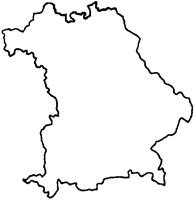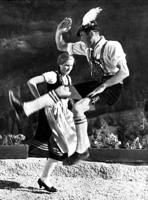
|
The Society of Folk Dance Historians (SFDH)
Choreogeography:
[
Home |
About |
Encyclopedia | CLICK AN IMAGE TO ENLARGE |

|
 German immigrants made a major contribution to the collective character of those who founded America. Their work ethic, concern for craftsmanship, and talent for producing high quality goods set an example for those who they joined in the mix of cultures that became Americans. Even today, German craftsmanship and engineering remain the standard for others to follow.
German immigrants made a major contribution to the collective character of those who founded America. Their work ethic, concern for craftsmanship, and talent for producing high quality goods set an example for those who they joined in the mix of cultures that became Americans. Even today, German craftsmanship and engineering remain the standard for others to follow.
In any society, the dance produced by that culture clearly reflects the values and aesthetics of those who created it. The dances of Germany are no exception. In the industrial north, home to huge manufacturing enterprises, the most common dance form is the Set Dance, frequently in Quadrilles executing intricate and charming figures requiring well-coordinated movements by every dancer – just as in a piece of complex machinery. Sauerlander Quadrille is one well-known example.
To the south, in mountainous Bavaria, the people are much closer to nature. The splendid scenery and bracing mountain air lend to an outdoor life and the Bavarians do it with serious zeal. As one might expect, their most popular dance, the Schuhplattler, mimics not machinery but wildlife – the "aurhan," the famous ring-tailed wood grouse.
 As large as a small turkey, the aurhan cock preens and struts in front of the hen on a fallen log, beating his wings to create a rhythm to impress the object of his lust. It works when the hen responds by turning in circles before him. The Schuhplattler does the same thing.
As large as a small turkey, the aurhan cock preens and struts in front of the hen on a fallen log, beating his wings to create a rhythm to impress the object of his lust. It works when the hen responds by turning in circles before him. The Schuhplattler does the same thing.
The men's dance consists of a syncopated series of very loud slaps on lederhosen-clad thighs and the soles of the shoes (thus "schuhplattler" or "hitting the shoe"). Every district has its own unique plattle (slapping rhythm), many of them very complex, all requiring strength, flexibility, and stamina. Couple plattles are danced in 3/4 rhythm.
As the men plattle, the women turn in a never-ending "dreher" or spin, either traveling around the men or remaining in place. Again, different regions have different footwork, either stepping on counts 1 and 3 or on every beat; both are one of the more difficult dance techniques for the women to master. Any time she is not dancing with her partner, the woman's skirt must be belled out fully. Between plattles, the men pursue, capture, and waltz with their partners. Just as in nature.
Tradesmen's plattles, danced in 2/4 time, frequently utilize implements and tools of the trade. There are loggers' plattles that use a log, cross-cut saw, and axes; miners' plattles use a rock, hammers, and musical chisels; cowherds' plattles use cow bells. Benches, staffs, and other props are frequently used in plattles where men play tricks on one another and even stage mock fights.
Annual contests, called "gaufests," pit Schuhplattler performing groups from across the country in a Schuhplattler marathon. Groups draw to determine which one of three different plattles they will perform: Haushammer, Hightauer, or Reit im Winkle. Each group must have all three plattle performances competition-ready. And the competition is strict. Total unity within the group is paramount: arms must all be at the same angle and height, feathers in hats must be at the same angle – and turn at the same rate, skirts must be perfectly belled, five men plattling must sound like one, only deafeningly louder. There's not a smile anywhere. Each group is free to create their own choreography within the structure of the plattle and design its own costumes, but every dancer must look and move just like all the others, with no one individual identifiable from the rest. (There is an interesting similarity to the Scottish country dance.)
So, in the Schuhplattler we see the expression of the Bavarians' close ties with nature, their concern with precision and power – and the dour German personality with which they perform this wonderful dance.
DOCUMENTS
- Richard Duree, an article.
- Schuhplattler, an article.
Used with permission of the author.
This page © 2018 by Ron Houston.
Please do not copy any part of this page without including this copyright notice.
Please do not copy small portions out of context.
Please do not copy large portions without permission from Ron Houston.